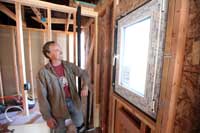Vic Weber's home in the old township of Soldier looks like any other farmhouse from the outside. But the house, built in 1910 just northeast of Fairfield, is undergoing a massive renovation that will result in using 90 percent less energy for heating and cooling—even in the dead of winter.
"Reduced energy consumption is as green as you can go," Weber said. "The climate is challenging, and the heating season is long and harsh, [but] it's doable."
Weber is a head consultant with the Zeph-ER Group, which designs passive-energy homes.
The Passive House Building Institute, based in Urnbana, Ill., sets standards for residential energy consumption and performance.
Unlike the Leadership in Energy and Environmental Design (LEED) standard, which awards points based on many environmentally friendly choices such as sustainable building materials, passive house standards focus only on energy consumption. A passive-energy home uses as little energy as possible by limiting heat loss and reducing energy consumption without using expensive solar-powered electricity.
"We're not allowed to use photovoltaics [solar energy] to meet our standard," Weber said. "We focus on conservation, not on being able to generate our own energy."
This is accomplished through using super-thick insulation and high-end, gas-filled windows. Weber said he stripped the house down to the 2x6 studs and packed the cavities with super-dense insulation, with an additional 6 inches of rigid foam insulation. With siding, the walls are roughly 14 inches thick, nearly double the thickness of a standard outside wall.
The insulation helps prevent "thermal bridges," Weber said.
"A typical stud wall, it's basically a heat bridge to the outside," he said, as the wood studs conduct heat from inside the home to the chilly outside. "We eliminate any easy access for heat to leave the house."
Efficient windows help with this goal. Weber said the price of his super-efficient krypton gas-filled windows added significantly to the cost of his retrofit, but the extra cost was crucial to meet design standards.
"If I wasn't doing a passive housing project, I wouldn't have used the windows I did," he said. "The climate was such that we needed these windows to make this work."
The airtight nature of the home does pose a challenge, however. A house built to code has natural ventilation as air comes in through gaps in crawl spaces, around windows and outside doors or any other crack or cranny where cold air creeps in—from what Weber calls "all the worst parts of the house."
Weber said the air in his 2,500-square-foot passive home is completely pumped out and renewed every three hours. The incoming air is heated through several methods, including a ground-based heat exchange system where the natural heat of the ground slightly warms intake air, and another where the exhaust air helps to boost the temperature of the intake air.
<
These systems eliminate the central furnace and make the home's air far fresher than anything in a house built to code, Weber said.
"Can you imagine flushing all your air out when it's negative 20 [degrees] outside?" he said. "People won't do it. So they stay inside with the cruddy air, and that's why people get sick in the winter.
"In a passive house, you have a constant stream of fresh air coming in. The air quality is unmatchable."
Weber has also used several techniques that are not unique to passive houses, but contribute to the home's energy-efficient nature. Active heating and cooling needs are estimated to drop by 90 percent when the retrofits are complete, but Weber said he hopes total energy costs will drop by 70 percent.
"We're energy misers," he said with a laugh. "We're stingy, we're cheap, so [we think], where can we get free energy?"
So the turn-of-the century farmhouse will be equipped with solar-powered radiant heating in a few of the rooms—bedrooms, mostly—and a solar hot-water heater.
But all of these improvements come at a premium, Weber said. While he explained that the house is being so thoroughly renovated that it's hard to separate the costs of the passive measures from more standard improvements, he estimated that building to passive energy standards increased the remodel costs by 10 to 15 percent.
"We're still kind of knee-deep in it, so it's hard to quantify," he said. "The home needed a new roof, the siding was shot. The entire kitchen is being remodeled, but what's 'passive house' about that?"
However, he added, because the home uses so little energy, residents in a passive home would be inoculated against rising energy costs in the future.
Currently, less than two dozen certified passive homes exist in the United States, and Weber said his home will be the first in the state. He said he hopes that the passive house movement will catch on in the area, as regional residents become more aware of how much energy can really be saved.
LEED-standard homes are becoming more popular, and passive homes can easily qualify for LEED certification on energy standards alone. While Weber said there are multiple "green building" standards in use in the United States today, passive houses qualify for certification under many of them.
Once the house is completed, Weber said, he hopes to have an open house in which interested people can tour his home and see up-close the improvements he's made.
"The goal of the project is to be a prototype for the area," he said. "In the end game, I'll have a showcase house for people all over Idaho to see."
Katherine Wutz: kwutz@mtexpress.com


 Vic Weber, a U.S. Navy pilot turned passive-home-design consultant, admires the airtight windows he has installed in his family’s 1910 farmhouse as part of an energy-efficient retrofit. Photo by David N. Seelig
Vic Weber, a U.S. Navy pilot turned passive-home-design consultant, admires the airtight windows he has installed in his family’s 1910 farmhouse as part of an energy-efficient retrofit. Photo by David N. Seelig



































